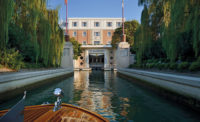Ribera del Duero, Spain
From the founding of their namesake monastery in 1145, the clerics of Santa María de Retuerta pursued Roman Catholic values of work, peace, and hospitality. Although monks have not occupied this corner of Spain’s Sardon del Duero area since 1931, contemporary visitors to their former abbey subscribe to the same principles, but in the reverse order. Abadía Retuerta LeDomaine today nourishes the collective spirit as a five-star hotel where staffers outnumber guests three to one. The hospitality destination’s spa lends additional tranquility to the idyllic vineyard setting. And for those who insist on productivity, the reimagined landmark includes meeting rooms for as many as 150 people.
The Santa María de Retuerta estate encompasses 1,730 acres; the chemical company Sandoz purchased the property in 1988 for its agricultural division, bottling a first vintage of wine there in 1996—the year the owner merged into Novartis. Six years later, the Swiss pharmaceutical giant decided to rehabilitate the abandoned Baroque-Romanesque structure on the site, and one of the company’s longtime architect collaborators, Marco Serra, started work in earnest in 2006. Serra invited the German lighting design firm Licht Kunst Licht (LKL) to take part in the conversion, which integrated 22 guest rooms, two restaurants, a bar, lounge, winery, and administration facilities into the archetypal Benedictine-style layout.
In addition to its spatial configuration, the abbey’s weighty masonry structure features tiny apertures common to the building type, says LKL director Martina Weiss, who adds, “The lighting was key to transforming the cool atmosphere into a place where people feel comfortable.” Weiss also notes that historical protections limited the illumination strategy: “You can’t recess any luminaries into the structure; every element has to be applied.”
LKL conceived custom fixtures made of thick sheets of folded bronze that would strike the right balance of gravitas and delicacy. As Weiss puts it, “We needed a luminaire strong enough to stand out on its own and still look pure and simple, like the monastery.” The bronze not only complements the abbey’s massive limestone walls visually, but also represents the ancient craft tradition with which they were made.
The design team sourced the ribbonlike floor and table lamps, spheroid pendant, and minimalist sconces from a producer of bronze high-mast lighting in Bavaria. Although this manufacturer had not created smaller-scale fixtures before, it undertook the commission with time-honored artisanship. The craftsmen abraded outward-facing bronze surfaces by hand to give them an even weightier, more dimensional appearance, burnishing the interior faces to a warm gold finish. Pleased with the meticulous attention to detail, LKL employed the company to fabricate the hotel’s exterior components, which include illuminated bollards, light poles, and pendants.
Positioning components demanded a less precise methodology. “The plan may have had specific lighting points, but we would arrive on-site to find that the crews couldn’t draw power, so we had to respond by changing the placement and rhythm of the luminaires,” Weiss says. In particular, the sconceand floor lamp–illuminated corridors overlooking the abbey’s courtyards required trial runs. LKL also went onsite to finesse the outdoor lighting, to ensure that the low-intensity 2,500-Kelvin (K) metal-halide lamps did not interfere with the night sky.
Off-the-shelf products also contributed to the metamorphosis of the ascetic 12th-century structures into a warm, inviting destination. LKL aimed discreet surface-mounted spotlights on a fresco of the Last Supper in the refectory and on the groin vaults of the abbey’s church, which now serve as a Michelin-starred restaurant and event venue, respectively. Uplighting tucked in a cove highlights the ornate oval dome above the main visitor stair.
The hotel Abadía Retuerta LeDomaine opened in 2012 to widespread acclaim and solid bookings; its instant success compelled management to crystallize plans for growth—this time overseen by trusted Novartis collaborator Diener & Diener Architekten. The architects reallocated former stables for eight additional guest rooms and constructed the Santuario spa entirely underground.
Staying on for the additional project, LKL differentiated the new spa by designing a mold-blown glass LEDilluminated pendant, producing it in multiples and suspending it from the ceiling of the indoor pool and reception room in clusters. “You don’t have to pretend it’s old,” Weiss says of the whimsical installation, adding that executing this scheme in an opaque material could have made the subterranean space feel smothering. In a show of continuity, the glass volumes are accented in bronze, and the converted stables are filled with the original custom luminaires.
Phase 2 allowed LKL to revisit the initial 2012 project by replacing the halogen lamps in its custom sconces and desk lamps with 2,500 to 2,700K LEDs. Plans are in the works to similarly retrofit all remaining interior fixtures throughout the property. Glowing with 21st-century design and technology, this medieval retreat is now prepared to share its hospitality and peaceful surroundings with visitors for years to come.
PeopleArchitect: Marco Serra Architekt (hotel); Diener & Diener Architekten (spa)
Lighting Designer: Licht Kunst Licht - Andreas Schulz, principal; Martina Weiss, project leader
Consultants: Marlene Doerrie (interior design, hotel); Michele Rondelli (interior design, spa); August Künzel (landscape architect)
Size: 330,000 square feet
Cost: withheld
Completion Date: July 2015 |
ProductsCustom Bronze Fixtures Bergmeister Leuchten
Interior Lighting GE (cove); Flos (downlights); Wibre (pool); Santa & Cole (table lamps)
Exterior Lighting Bega, Hoffmeister, Vibia
|










Post a comment to this article
Report Abusive Comment